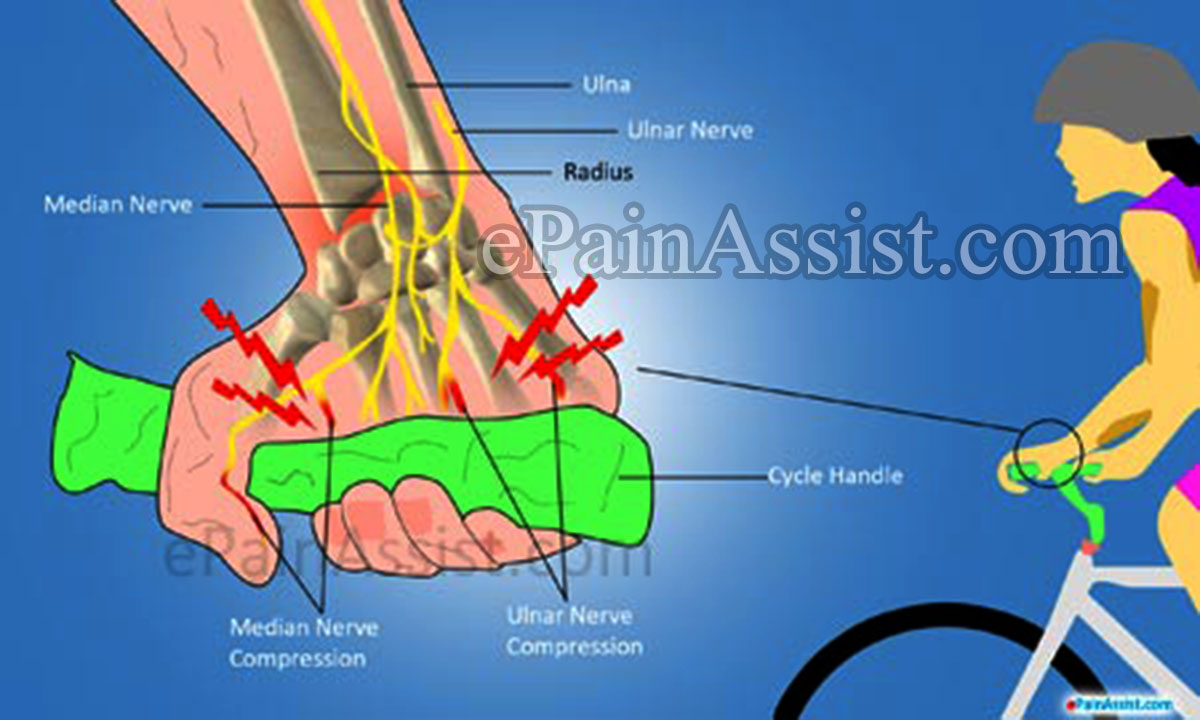What is Handlebar Palsy?
Handlebar palsy[1] is also known as ulnar neuritis or ulnar neuropathy. This condition is generally experienced by long-distance cyclists. In handlebar palsy, the ulnar nerve in the wrist gets compressed due to the long periods of direct pressure on the nerve when the weight of the upper body is resting on the handlebars, thus the term handlebar palsy.

Causes of Handlebar Palsy[2]
- Handlebar palsy is caused due to compression of the ulnar nerve in the wrist.
- Handlebar palsy, as the name suggests, is most frequent in cyclists due to compression of the ulnar nerve because of positioning of the wrists on the handlebars.
- Handlebar palsy could also be caused by disruption or compression of the ulnar nerve at the elbow because of bone spurs, trauma, cysts and arthritis.
- Handlebar palsy may occur by repetitive movements at the wrist or elbow.
- Sports activities which involve weight lifting, throwing and biking may also cause handlebar palsy.
Signs and Symptoms of Handlebar Palsy
- Difficulty while performing typical hand functions like using pen, using surgical equipment, or playing piano.
- Clawing of the hand.
- Affected fingers may fail to work properly.
- Outer half of the ring finger and little finger along with outer portion of the hand typically get affected.
- Pain while performing wrist activities.
- Difficulty straightening out the ring and pinky finger of the affected hand.
- Numbness, weakness and tingling could be experienced.
- Lack of coordination or clumsiness in the hand is felt.
Treatment for Handlebar Palsy[3]
Handlebar palsy is generally a self-limiting type of nerve injury where the nerve regenerates on its own restoring normal functioning of the muscles, but this may take several weeks to months depending on the severity of the injury. The patient needs to avoid performing sport activities during recovery period. In case of cyclists, it should be ensured that the right size of bicycle and proper position of the handlebars is used.
Medications such as over-the-counter pain relievers or prescription pain medications may be used to help control the pain. Corticosteroid injections may be performed to reduce swelling and ease pressure on the nerve. Supportive splint or protective pads may be used at the elbow or the wrist to avoid repetitive trauma and prevent further injury.
Surgery[4] may be warranted in severe cases to relieve the pressure on the nerve, specifically if there is evidence of wasting away of the ulnar nerve.
Physical therapy is important in speeding up the healing process and to get optimal results. Physical therapy also decreases the likelihood of recurrences in the future. Physical therapy may include:
- Soft tissue massage.
- Electrotherapy.
- Heat and ice treatments.
- Bracing or splinting.
- Exercises to improve the strength and flexibility.
- Activity modification and training.
- Appropriate plan for return to activity.
Exercises for Handlebar Palsy[5]
Active Elbow Flexion and Extension: This exercise is performed by bringing up the palm toward the shoulder and bending the elbow as far as possible. Lastly straighten the elbow as far as possible for 10 times. Perform 3 sets of 10.
Wrist Extension Stretch: This exercise is performed by keeping the elbow in a straight position and placing the fingers flat on a table with palms facing downwards direction. Next step is to lean the body weight forward and hold the position for about 15 seconds.
Wrist Flexion Stretch: This exercise is performed by keeping the elbow in a straight position and placing the hands on a table with palms facing upwards direction with fingers pointing towards the direction of the body. Next step is to lean away from the table and hold the position for about 15 to 30 seconds.
Straight Finger Flexion: This exercise is performed by making a right angle with the knuckles and keeping the fingers straight. Hold this position for 10 seconds. Repeat this 5 times.
Finger Squeeze: This exercise is performed by squeezing the objects between the fingers individually by using pens, sponges and paper. Hold this position for 10 seconds. Repeat 5 times for each finger.
Grip Strengthening: This exercise is performed by squeezing a rubber ball and holding it for 5 seconds. Perform 3 sets of 10.
Tests to Diagnose Handlebar Palsy
A thorough examination from starting point of the problem and the reason for the injury or damage caused to the nerve is really important. An examination of the wrist and hand reveals dysfunction of the ulnar nerve including signs such as:
- Claw-like deformity.
- Difficulty with finger movement.
- Muscle wasting of the hand.
Additional diagnostic tests may be required to confirm the diagnosis and the extent of the injury. These may include:
- Blood testing.
- X-rays.
- Electromyography. (EMG)
- Nerve conduction velocity.
